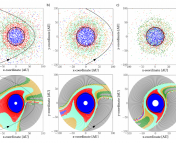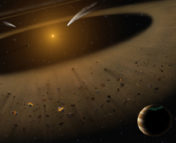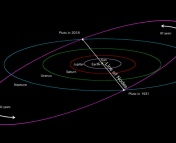This guest post was written by Sarah Jaffa. Sarah completed her PhD at Cardiff University in 2018, working on statistical measures of structure in star forming clouds and clusters. She is now a postdoctoral research fellow at the University of Hertfordshire performing simulations of star formation in different environments.
Title: Cradle(s) of the Sun
Authors: Susanne Pfalzner and Kirsten Vincke
First Author’s Institution: Jülich Supercomputing Center and Max-Planck-Institut für Radioastronomie, Germany
Status: Published in The Astrophysical Journal, open access on arXiv
The birth-cluster of the Sun
Most stars and their planets form in clusters, with lots of young stars forming all at once out of a collapsing molecular cloud. If we want to learn more about our solar system — why the Sun, the planets, and the Earth are the way they are — and whether we can find similar systems elsewhere, it is useful to know what sort of cluster the Sun formed in.
This is a question astronomers have been asking for a long time, but recently we have learned a lot more about star clusters with the help of missions like Gaia. The paper covered in this post uses that new information to test what sort of cluster the Sun might have formed in. Suzanne Pfalzner, the lead author of this paper, told this author, “Five years ago we [asked] the same question, but then a lot about young cluster dynamics was uncertain. Gaia 2D brought a lot of progress in the observational side of this field, so that we felt confident now to give a much better answer” (“Gaia 2D” refers to the second data release from the Gaia mission).
How do clusters influence planet formation?
We know that a cluster can be a dangerous place for a young star trying to form some new planets. Radiation and winds from massive stars can evaporate the planetary disc, and the gravitational pull from fly-bys of other stars can disrupt the disc and drag the planet-forming material away.
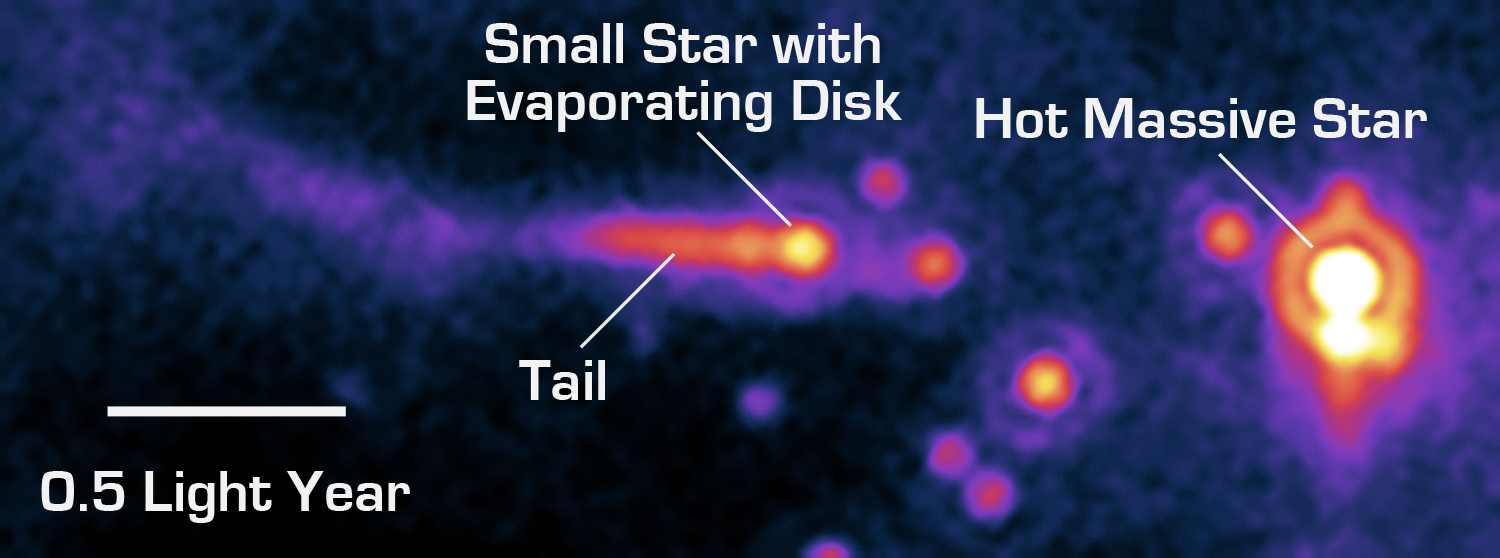
Both of these effects (radiation and gravitational disruption) will depend on the mass of the stars involved. Massive stars in the cluster give off more radiation, but previous studies suggest that only discs around small stars that are less than half the mass of the Sun are greatly affected by this. For medium-sized stars such as ours, the greatest risk is from the gravitational disruption of a close fly-by.
How can we learn about the solar system’s past?
There are clues in the present solar system that can tell us about the environment in which it was born. Meteorites are made of the same material that formed Earth and the rest of the planets but they haven’t been affected by all the pesky chemistry and organic stuff that we have here. So, they can give us a handle on the chemical makeup of the cloud the Sun was born in. Particularly, short-lived radionuclides which we believe to be produced in supernovae give us an estimate of how many massive stars there were in the cluster. We can use this information with the known Initial Mass Function to work out the total number of stars and therefore, the total mass of the cloud. Previous work used these limits to suggest that the Sun’s birth cluster had to have had more than 1000 stars.
Another method looks at how close encounters between the baby Sun and neighbouring stars would have affected the shape and angle of the disc that eventually formed Earth and the planets. That is where this is where this paper comes in. The expected shape for a protoplanetary disc is thin and round, with the density decreasing towards the edge, but our solar system doesn’t have this ‘tapering edge’ that we expect. Neptune, the furthest planet, is at ~30AU and the Kuiper Belt extends from ~30–50AU, but then nothing… as if the edge of the disc was stripped away. Pfalzner explains, “This is part of our investigation of whether the puzzling distribution of the outer solar system objects could have been caused by the close flyby of another star.”
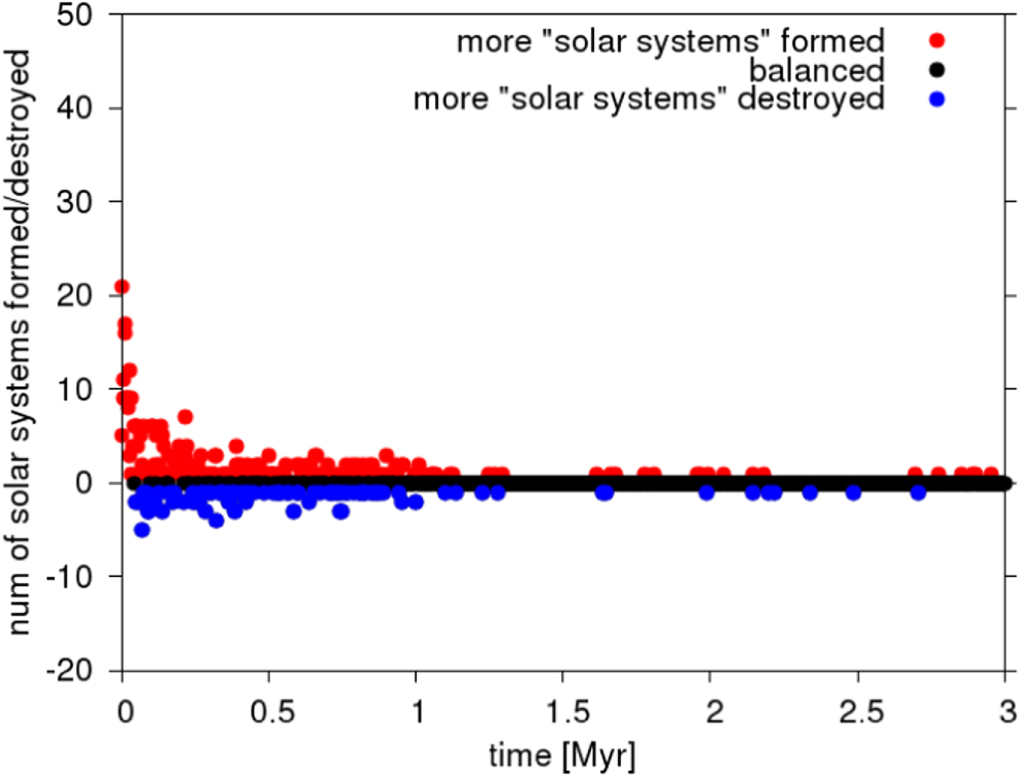
To solve this puzzle, the authors performed N-body simulations of a set of star clusters, matching the size and number of stars to some observed clusters (Mon R2, the ONC, NGC 6611, M44, NGC 3603). Each cluster was allowed to evolve under gravity, and each star remembered every time it had a close encounter with another star, what the mass of that star was and how close it came. The authors then used an analytic expression that was calibrated to much smaller detailed simulations in another paper to calculate how much of the disc would be stripped away in each encounter. This allowed them to see when each star became a ‘solar system analogue’ (SSA), which they defined as a star with mass 0.8–1.2 times that of the Sun having a disc with radius 30–50AU.
They found that, as expected, dense clusters have more close fly-bys which can make the disc small enough to become an SSA. But unfortunately it isn’t that simple, because the SSAs may continue having fly-bys and become too small! In fact, in all the different clusters the number of SSAs gradually decreased over the course of the simulation. The main factor affecting the number of SSAs at the end of the simulation was the central density of the initial setup. However, this work was looking only at the gravitational interactions, so the authors discussed what other processes might affect the discs.
The radiation from massive stars, as mentioned above, will also make the discs smaller, and this is likely to destroy the discs in the densest clusters. In Figure 6 from the paper, the authors estimate the effects of this photo-evaporation on the amount of SSAs and find that the most likely type of cluster as determined by gravitational interactions is now not very likely at all. The authors conclude that the cluster the Sun formed in must have been something more like M44 or NGC 6611 – an intermediate mass environment where the baby Sun would experience some fly-bys, but not too many, and the disc would survive long enough to form asteroids, planets, and eventually, us.
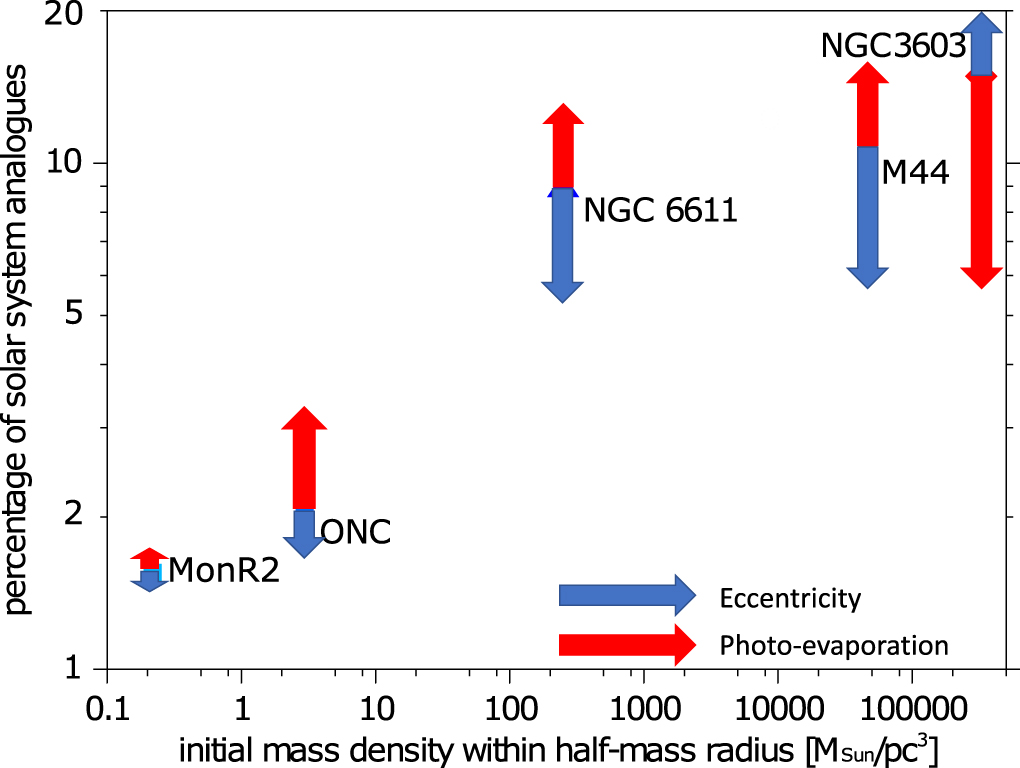
Astrobite edited by: Tarini Konchady
Featured image credit: NASA/JPL-Caltech/Univ. of Ariz./Univ. of Szeged

